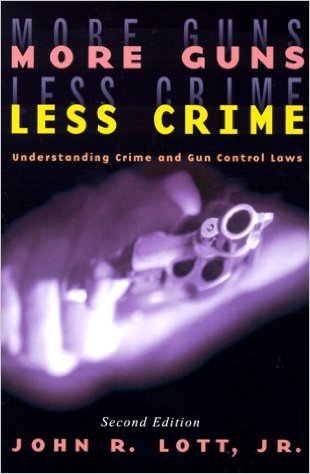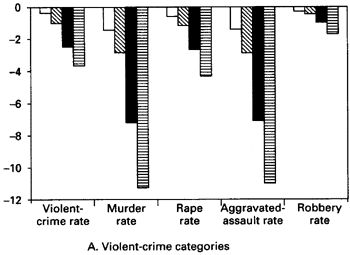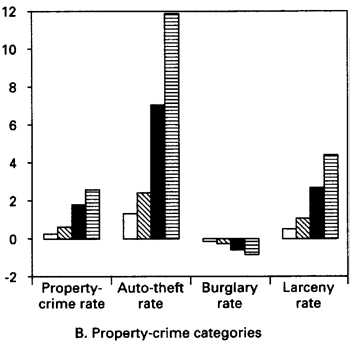Opening Fire
Thomas Jackson, American Renaissance, June 2000
More Guns, Less Crime: Understanding Crime and Gun-Control Laws, John R. Lott, Jr., University of Chicago, 1998, 225 pp.
How strange it must be to be a liberal. Driven by slogans, blinded by superstitions, dazzled by fantasies, the liberal stumbles through life oblivious to facts. There is almost nothing the liberal thinks he knows about race, social policy, sex roles, individual differences, and even history that is not some combination of slogan, superstition, and fantasy. John Lott’s soberly brilliant More Guns, Less Crime could not possibly be a more convincing demonstration that what liberals think they know about guns is fantasy, too.

The liberal view, of course, is that private citizens should not have guns and that gun control will stop violence. Prof. Lott, who teaches law and economics at the University of Chicago, makes an air-tight case for the opposite view: that when citizens carry concealed weapons criminals are afraid to attack and violence declines. Prof. Lott’s approach is to track violent crime rates over time in those parts of the country that have liberalized gun laws as opposed to places that have not.
The most significant recent turning point in gun ownership regulation was the Florida legislature’s 1987 decision to adopt a “shall issue” policy on concealed-carry permits. Unlike the then-widespread practice of granting permits only to security guards and other select groups (which often included state officials), the new law ordered that local jurisdictions “shall issue” permits to everyone not obviously disqualified by such things as insanity or a criminal record. Any normal, law-abiding man or woman could get a permit to carry a concealed firearm. This was perhaps the first time that a state with large cities and lots of crime had reversed course on concealed carry.

Percent change in the crime rate with respect to differences in the percent of a county’s population that is black.
In 1985 there were only eight states with “shall issue” laws but now there are 31. This means we have a great deal of information on what happens to violent crime rates when there are suddenly a lot more guns in responsible hands, and the results could not be clearer: When citizens might be carrying pistols under their coats, the brutes think twice about doing them mischief.
Not surprisingly, the decrease in crime has been greatest where there was the most to begin with, and this means cities with large black populations. As Prof. Lott explains, “While many blacks want to make guns harder to get, the irony is that blacks benefit more than other groups from concealed-handgun laws.” As he notes, the percentage of young blacks in an area is the single variable that best predicts the level of violence. If the non-criminals in these places start carrying weapons it evens the odds and discourages predators — just as it does everywhere else — and there are more predators to discourage.
The graph on this page shows the average drop in violent crime the year after passage of a “shall issue” law, as a function of the percentage of the population that is black. The blacker the population the greater the benefit. Washington and New York City, which have some of the most restrictive gun laws in the country, would benefit greatly from letting honest citizens carry guns.
As the graph makes clear, for areas with few blacks the declines in violence are modest, but for the country as a whole, the effect is certainly significant. Prof. Lott concludes that if the entire country had liberal concealed-carry laws, in 1992 there would have been 1,400 fewer murders, 4,200 fewer rapes, 60,000 fewer aggravated assaults, and 12,000 fewer robberies.
This makes perfect sense. What criminals fear most is the possibility that an intended victim will pull a gun and blaze away. This fear is so great that changes in concealed carry laws have a measurable effect even when only a small percentage of people actually carry guns. Once the bad guys know that people might be armed, it pays to assume everyone is armed.
Criminals have always adjusted their tactics according to the likelihood of being shot. In Canada and Britain, about half the burglaries are “hot,” or committed while people are on the premises. In the United States, where people have always had guns at home even if they couldn’t carry them in the street, only 13 percent of burglaries are “hot.”
Prof. Lott points out that it is partly due to the quiet, undramatic way in which civilian gun ownership works that makes it easy for liberals to ignore its benefits. He explains that the best survey data suggest that 98 percent of the time, when someone uses a gun to deter crime he doesn’t even have to fire it. All he has to do is show it. Prof. Lott notes that while the media love to trumpet the 30 or so times a year that someone kills an innocent he mistook for an intruder, they pay almost no attention to what may well be millions of crimes prevented every year because someone waved a gun at a bad guy.
Although women are among the most crazed gun control advocates, they benefit the most from having guns. If a woman is attacked, she is least likely to be seriously injured if she resists with a gun. If she puts up no resistance she is 2.5 times more likely to be seriously injured than if she uses a gun. If she fights back without a weapon or with something other than a gun, she is four times more likely to be seriously injured than if she uses a gun.
For men, having a gun is not as effective in reducing the chances of injury because unarmed men are better prepared to resist attack than unarmed women. Resisting with a gun is always best, but a man who puts up no resistance is only 1.4 times more likely to be injured seriously in an assault than one who resists with a gun.
Even when the law permits it, women are less likely than men to carry guns. Prof. Lott finds that combined with the greater odds-evening effect for women, this means any given armed woman has a greater deterrent effect than any given armed man: “One additional woman carrying a concealed handgun reduces the murder rate for women by about 3-4 times more than one additional man carrying a concealed handgun reduces the murder rate for men.”

Percent change in crime rate with respect to differences in the percent of a county’s population that is black.

In the hysteria that accompanies any debate about passing “shall issue” laws, people always predict that armed citizens will get into gun fights over traffic accidents. Prof. Lott notes that there has been only one known case of a permit holder using a concealed handgun after an accident. The other driver savagely attacked him and he used his weapon only in extremis in what was found to be justifiable self-defense. No permit holder anywhere in the country has ever been known to shoot a police officer, though permit holders have certainly saved the lives of officers.
These findings justify the pro-gun slogan “if guns are outlawed only outlaws will have guns.” Criminals carry and use guns no matter what the law says. People who go through an application process and are found not be crazy or criminal use guns responsibly. Prof. Lott notes that very few murderers, for example, would even qualify for a concealed-carry permit, much less bother to get one. Eighty-nine percent had criminal records before they became killers.
Do concealed carry laws have costs? Unlike the dire predictions of gun control advocates, they have no effect at all on accident or suicide rates. They do, however, have a spillover effect, both geographically and in type of crime. If one jurisdiction issues permits and a neighboring one does not, violent crime — quite logically — increases on the side of the border where citizens cannot protect themselves. Criminals prefer unarmed prey.
Another effect is that malefactors who are now afraid to attack people go after property instead. When the costs of one kind of crime go up, they try something else and again, the effect is greatest where there is the most crime. The graph on this page shows the increase in property crime that accompanies the decrease in violent crime after the passage of “shall carry” laws. Like the previous graph, the change is shown as a function of the percentage of the population that is black. The increase is unfortunate, but for most people, more car theft is an acceptable price to pay for less murder or rape.
Prof. Lott found another interesting effect of concealed-carry laws. They can cause a short-lived increase in mass shootings — the kind in which someone blazes away randomly at a crowd — which is soon followed by a decline. Prof. Lott suspects that some number of mass killers are prompted by the new laws to get on with the mayhem before too many permits are issued and the chances of return fire become too great.
More Guns, Less Crime also concludes that several other policies people think make a difference do not. He finds that imposing waiting periods or restricting the number of guns people can buy in a month does not reduce crime. Nor are concealed carry laws any more or less effective when they require permit holders to go through gun safety training. Like so much of what government does, this is pure eyewash. Though Prof. Lott does not mention them, many other much-ballyhooed anti-gun measures like bans on “assault weapons” and limiting magazine capacity have probably been just as meaningless.
Prof. Lott finds that arming the citizens is sound policy from every angle: “[C]oncealed handguns are the most cost-effective method of reducing crime that has been analyzed by economists; they provide a higher return than increased law enforcement or incarceration, other private security devices, or social programs like early educational intervention.”
But does a case for more guns have even a ghost of a chance of getting a fair hearing? The more irrefutable it is, the worse its chances. Prof. Lott presented his central findings in a research paper before he wrote this book, and recounts some of the lessons he learned about the liberal approach to facts:
I never would have guessed how much people fear discussion of these issues. I never would have known how much effort goes into deliberately ignoring certain findings in order to deny them news coverage. Nor would I have seen, after news coverage did occur, how much energy goes into attacking the integrity of those who present such findings, with such slight reference — or no reference at all — to the actual merits of the research. I was also surprised by the absolute confidence shown by gun-control advocates that they could garner extensive news coverage whenever they wanted.
Here in a nutshell is both the liberal mindset and the liberal advantage: Ignore all research that undercuts the orthodox view. If it can’t be ignored, attack the researcher rather than the findings. In all cases, stamp out dissent with barrages of friendly news coverage, which can be called in at any time.
As it is with so many of the important questions of our time, good policy is crushed under superstition and fantasy. Blacks and women — people about whom liberals claim to care deeply — benefit most from the right to bear arms, but thousands are murdered, raped, robbed, and assaulted for no other reason than nanny-state bigotry. As has happened over and over, the left wins and the people lose.















